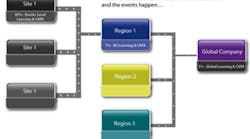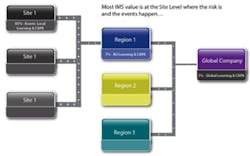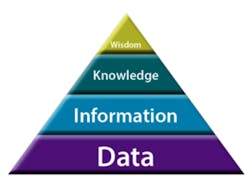Plant Safety: Effectively Share Insights from Incidents
We all are continually learning. Learning from our own mistakes as well as from the experiences of others makes us better prepared to deal with future events. Organizations are no different — successful ones use insights gained from mistakes, incidents, accidents and other undesirable occurrences to improve.
Identifying those lessons you really must learn, regardless of their source, and putting into action a process to take advantage of the learning is the very definition of continuous improvement that can make your organization safer, smarter and more sustainable. The opportunities those lessons afford can play a key role in remaining competitive, effective, efficient and profitable.
Every site in your organization spots local opportunities. However, some ideas, e.g., ones related to operational improvement or process safety, that could have broader applicability often don’t get entered into a corporate knowledge- or incident-management system because site staff don’t appreciate their wider value to the organization.
Only a small percentage of opportunities identified at a facility will be important to its larger business unit. Even fewer will have enterprise-wide relevance (Figure 1). However, those that do must be managed in an efficient and effective way.
[javascriptSnippet ]
An organization should look for more than internal ideas. It should check for opportunities uncovered elsewhere. Regulatory bodies often spell out general lessons from major events. So, review high-profile incident investigations and findings — e.g., on the explosion at BP’s Texas City refinery, the Buncefield fuel-depot disaster in the U.K., and the Fukushima nuclear catastrophe in Japan — for opportunities that might apply to your organization. Changes in reporting requirements by the U.S. Environmental Protection Agency and Occupational Safety and Health Administration, and the U.K. Health and Safety Executive’s Control of Major Accident Hazards (COMAH) regulations also mandate all facilities to react and adapt.
In addition, you must consider how your organization manages global opportunities today. Often, it involves casual or informal sharing. Unfortunately, this usually is inadequate because the appropriate people in your organization may not see or understand the opportunities. Companies are using different techniques today to address this tough problem — with mixed results. We recommend an approach called HUAA that has proven effective.
A More Effective Approach
HUAA stands for Heard, Understood, Acknowledged and Actioned. It consists of the following core steps:
1. Identifying opportunities (Heard);
2. Entering them into an electronic system;
3. Having experts review them (Understood),
4. Accepting or rejecting them (Acknowledged); and
5. Assigning each to leadership to resolve and track to closure (Actioned).
A good HUAA process provides visibility to leadership about the opportunities being identified, and reports on the progress in real time (Figure 2).
The approach offers a number of other significant benefits:
• Efficient collection. Important opportunities from many sources (internal and external) are collected and entered into the HUAA management system, streamlining the recording process and getting the opportunities quickly to decision-makers.
• Expert review. These opportunities are vetted, parsed and resolved for inclusion or exclusion, with the decision documented and communicated.
• Accountable assignment. Accepted opportunities are systematically assigned to leaders and managed across the enterprise at the executive level.
• Action. Leaders are held accountable for their actions. Moreover, results of their actions as well as inaction can be seen real time, which spurs action.
• Results. The organization will gain competitive advantage by active listening, learning from its experience as well as the experience of others, and by taking action. The results of the process can be audited, judged and continually improved.
The HUAA process can underpin an organization’s knowledge-management strategy and provide the most important part — action!
Figure 2. This formal process involves several distinct steps and requires both feedback to the idea initiator and action.
HUAA Steps
The management system is a blend of people, technology and process. All the pieces must fit together and work efficiently. Probably the most important design element is the visible accountability of everyone involved, which allows leadership to constantly review progress and ask questions about global opportunities and their closure. Let’s take a deeper look at each of the HUAA steps.
Heard. First, opportunities must be heard. That means key staff members (idea generators) must be on the lookout for opportunities at all times in all places. They must be active attendees at events that might produce an opportunity. For instance, a key mechanical engineer might be charged with going to meetings of the American Society of Mechanical Engineers and even participating in groups developing industry guidance. A process safety management (PSM) specialist might attend meetings of AIChE’s Center for Chemical Process Safety and the Mary K. O’Connor Process Safety Center International Symposium and even volunteer to chair a working group. This PSM person also must keep up-to-date on, e. g., safety incidents occurring in the industry as well as changes to PSM and risk-management-plan rules, suggested or on the horizon.
After identifying a potential opportunity, the idea generator enters it into the HUAA management system. This involves explaining what the opportunity is and why it’s important to the organization (upside and downside). The person should be gathering opportunities and entering them all the time.
Understood. Once an idea is captured, the HUAA process must initiate a quality review by the right person at the right time. Inaction should generate escalation so ideas don’t await review for too long.
The reviewer acts as gatekeeper, evaluating the idea for applicability (understanding), and either rejecting or accepting it into the system. The person also provides a value and priority for any accepted idea. The next step is the acknowledgment of the idea.
Acknowledged. The gatekeeper communicates the decision to the initiator and documents it in the system. If the idea is rejected, recording closure comments and sending these to the initiator closes the communication loop — the initiator has spent time and energy entering the idea in the first place and believes it has merit, and so deserves such feedback. Documenting the reason for rejection is a great way of monitoring involvement and the quality of the process.
The gatekeeper then selects a leader, like a plant manager, to be responsible for the accepted idea. Assigning a senior manager is an essential part of this process. The individual must be someone with the resources, both human and monetary, and influence to address the opportunity. More importantly, the person must be accountable to see that these important opportunities are handled appropriately.
Figure 3. Data provide the foundation but putting knowledge into appropriate context is the key to gaining wisdom.
The gatekeeper also must ensure the idea is assigned a priority (importance) that takes into account severity, frequency, etc. Setting that priority simply may involve checking a box for big, medium or small, or may leverage the corporate risk-ranking matrix with severity and frequency. Severity must consider safety, environment, reputation, assets, etc., to properly compare one opportunity to another. Ideally, both current and future risk should be identified for each opportunity.
Up to this point, there’s been motion but no action. Knowledge or wisdom without action is wasted.
Actioned. This step is where we reap the rewards of the HUAA process. Creating an action plan to address the opportunity, assigning actions and tracking those actions to ensure everything is achieved on time and to quality allow realizing the opportunity quickly, effectively and efficiently. The responsible person can develop an action plan on how to address the assigned idea in as much detail desired, and can make as many subordinates as needed responsible for specific actions. The person must set firm deadlines for all actions to underscore that things must get done. Monitoring progress becomes easy, as does confirming the value is realized. Continual monitoring ensures the opportunity remains satisfied. (Maybe we should add another “A” for auditing to the HUAA process — that would make it HUAAA!)
The audit step covers two angles — ensuring changes continue to be embedded into the operation of a facility; and understanding who is making recommendations for opportunities, their quality, and acceptance and rejection rate. This allows a holistic view not only of the volume but also of the quality of opportunities and reviews. It can assist in identifying any weaknesses in your HUAA process. For instance:
• Are opportunities being documented effectively to allow the reviewer to understand?
• Are the reviewers rejecting opportunities because of a weakness in their knowledge of a specific area?
• Are there people who you would have expected to enter opportunities who never have?
• Are there people who consistently miss their deadlines for actions?
All these finding can help make your HUAA process even more effective.
A good HUAA process relies on people. People identify, review and implement the opportunities. You must choose the right listeners and properly motivate them. If they are too busy, not interested, not experienced enough, too experienced or lack an innovative spirit, the process will flounder. People without adequate experience, education or curiosity won’t spot global learnings, concerns and opportunities. Those with the right credentials must be vigilant and feed the HUAA process as if the organization’s future depends upon it. It may!
The gatekeepers filtering and accepting/rejecting opportunities must be exceptional people who can be trusted to separate the wheat from the chaff. They should be held accountable for inclusion or exclusion. Likewise, it’s vital to hold members of the leadership team personally accountable for disposition of global opportunities assigned to them. Measurement by corporate-level executives and board members is essential to ensure you get value from the HUAA process. What gets measured really does get done.
The Keys to Success
To have a successful HUAA process, you must:
• Have the right automation for the job. It must be easy to use, intuitive, follow good business processes, enable reporting and auditing, and engage all users in the process.
• Empower the right people to be able to identify opportunities. Curiosity, innovation and a desire to improve, along with being given the time and space to go hunting for opportunities are key characteristics. Efficient identification and collection of opportunities is the foundation of HUAA.
• Empower the right people to make decisions on where the value lies in the opportunities identified. For example, a mechanical engineer reviews a new American Petroleum Institute recommended practice on mechanical integrity, while a PSM expert evaluates opportunities arising from findings of a U.S. Chemical Safety Board incident report. Properly prioritizing the opportunities means your business is kept safe, productive and profitable.
• Empower the right people to make the decision on how to implement the opportunity to get the best value. Using the people who best know the particular aspect impacted and have the authority to take action to manage the process is the most efficient way to make the opportunity a reality.
• Make everyone in the HUAA process responsible for his or her part in it. Responsibility breeds interest, involvement and commitment.
• Measure and continually improve. Getting better and better will allow you to identify opportunities.
A HUAA opportunity-management process helps ensure that vital initiatives and important opportunities are consistently and systematically identified, evaluated and prioritized. Imagine how much more efficient and effective an organization would run if we were taking advantage of all the knowledge around us.
If properly designed and implemented, a HUAA management system will ensure your overall organization’s risk profile is known, visible and manageable at the lowest level possible. Not having a HUAA management system may be the most expensive mistake you ever make.
Avoid Confusion
Many people use the terms data, information, knowledge, wisdom and ideas interchangeably but they have very different meanings.
• Data are numbers on a spreadsheet, maybe without context or units of measure.
• Information has context like units of measure. Data are turned into information by organizing them so one can easily draw conclusions. Data and information deal with the past.
• Knowledge has the complexity of experience, which comes about by seeing it from different perspectives. Information is static, knowledge is dynamic. Knowledge deals with the present.
• Wisdom is the ultimate level of understanding (Figure 3). We can share our experiences that create the building blocks for wisdom. However, imparting wisdom involves more than just such sharing; it requires putting knowledge into the personal context of the audience.
• Ideas are thoughts or suggestions as to a possible course of action. We refer to ideas in this discussion as “opportunities;” opportunities can be information, knowledge or wisdom.
MIKE BEARROW, PE, is principal consultant, process safety management, for Rolls-Royce Controls and Data Services, Houston. KIM TURNER is a consultant based in Nottingham, U.K. E-mail them at [email protected] and [email protected].





